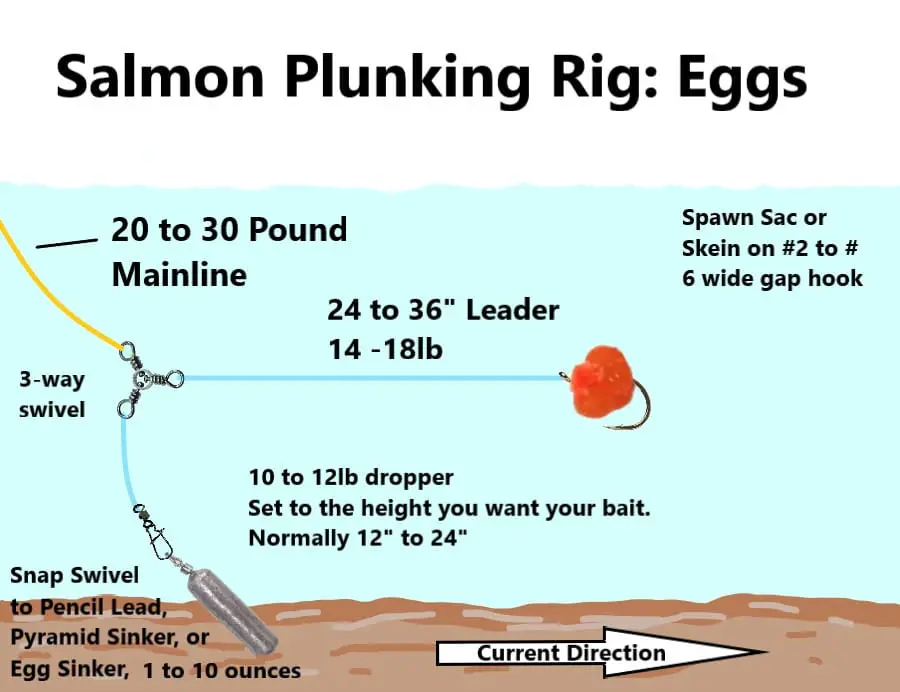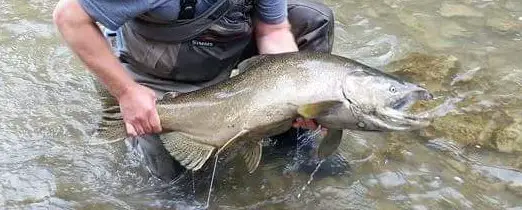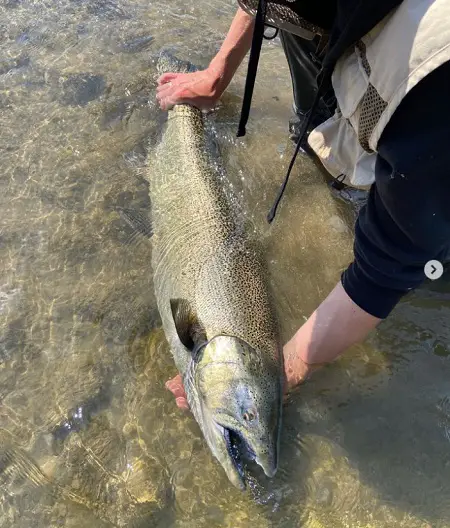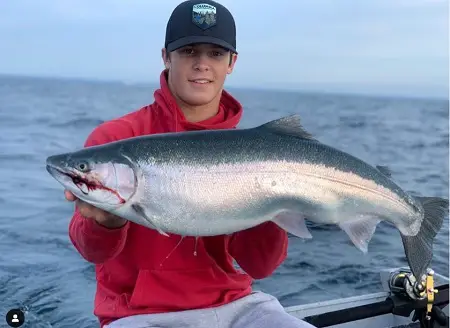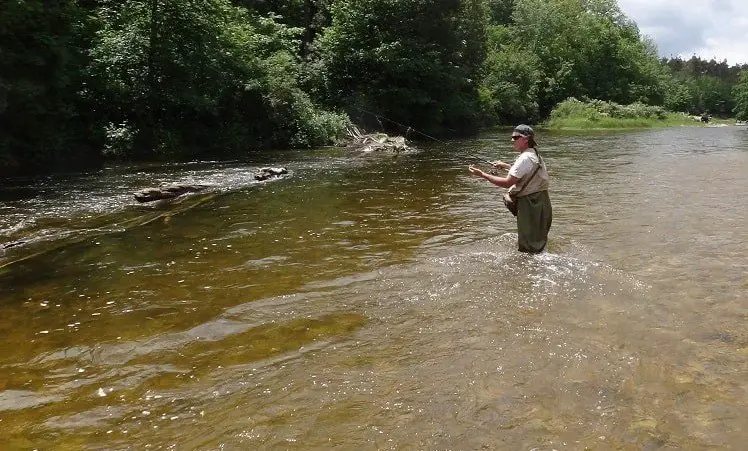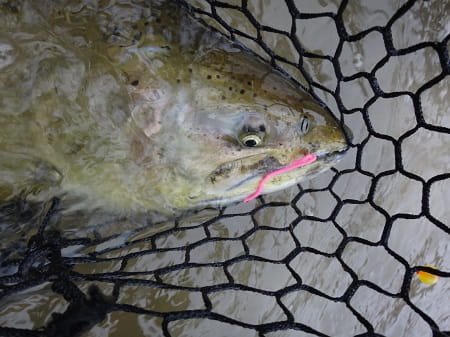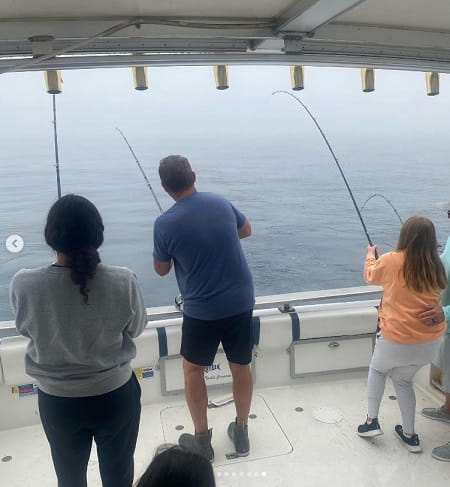Plunking For Salmon: The 2 Best Setups And Baits
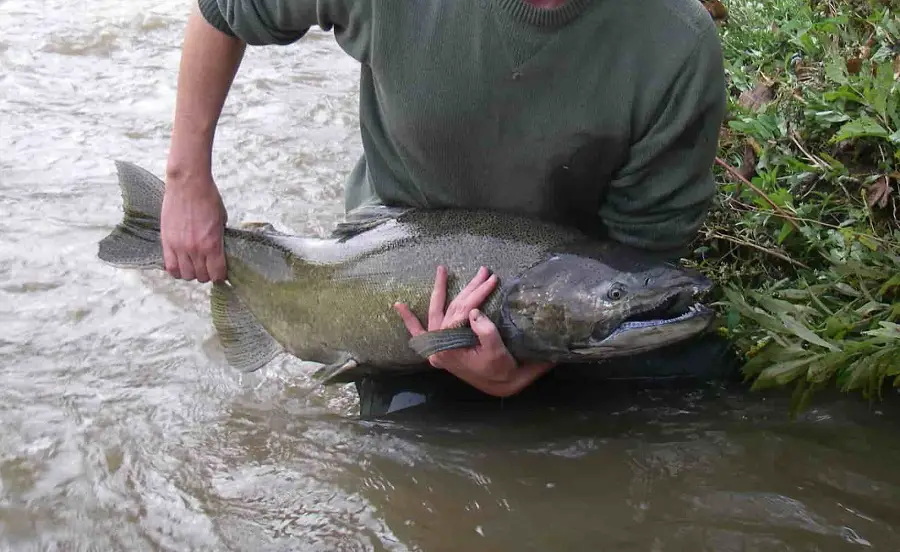
Plunking is an old-school method of catching salmon that is actually quite popular with both West Coast and Great Lakes salmon anglers.
Plunking for salmon is when you cast a bait out into the ocean or river and allow the large heavyweight attached to your leader to anchor and hold the bait near the bottom. You leave the bait in place and hope a salmon swims by and grabs your bait. Having a buoyant suspended bait works even better.
With plunking, you cast to an area where you think salmon will swim past, and you just wait for a bite.
It sounds easy, however, there are some tips and tricks that guides and experienced anglers use that will make plunking for steelhead more effective.
Plunking For Salmon
Often, anglers cast the bait out into the middle of the river, put the rod into a rod holder, and wait. It may take minutes or hours for a hungry salmon to swim by and grab their bait, or nothing will bite at all.
Periodically moving your bait around the pool and choosing high-percentage areas can greatly increase your chances. I will discuss this more below.
Also, only certain baits will work with this method, which I will also discuss in this article.
There are also certain hooks that work better than others, which will also be discussed in this article.
When Is Plunking Effective
Plunking is an effective technique for salmon fishing when the fish are moving through or when there are concentrations of fish in a spot.
Often, it’s the old-school guys near the mouths that are using this method the most. Part of the reason for this is that plunking in a pool where all the guys are drift fishing or float fishing doesn’t work well since their lines are always moving and can drag across your stationery line.
Plunking is a still fishing method, and because of this, it provides lots of time for the salmon to locate and see the bait. With plunking, you can get very deep and into spots the salmon will hold.
Plunking also allows you to position your bait along the bank where the salmon travel during high and dirty water. Your bait can stay in this spot for long periods of time and will be found by passing salmon.
Guide Tip: Locate concentration areas and place your bait in the middle. This may mean walking a long way, but if you learn how to read the river and the current, you can find water where the bulk of the salmon will travel through a narrow section of the river.
With a salmon fishing method such as plunking, an angler is able to fish at odd times, such as when the water is high and off-color.
Plunking is also not difficult to do, and even the newest angler can do it well. It does not require any special casting skills, just a good setup and some knowledge of where to fish.
Plunking also allows you to fish near the bottom all the time. Most salmon travel tight to the bottom so placing the bait 2 to 3 feet off the bottom is perfect.
It’s always good to have other options since plunking may not always be the best method in some river situations or spots. That’s why, after reading this article, it’s a good idea to check out my page, How To Catch Salmon In A River: Methods, Baits, and Setups Used By Guides.
Best Rods For Plunking
The recommended rods for plunking salmon include rod sizes that range from 9 feet to 12 feet. I prefer medium-heavy rods on smaller salmon rivers and heavy action rods capable of casting 6-8oz weights on large rivers and when casting into open water.
My preference is a rod rated for a 20 to 30-pound line.
Rod choices include Lamiglas, Ugly Stik, Shimano, and Loomis SAMR 1265 C. Specific rods like the Lamiglas Insane Surf or the well-liked extra Heavy 10’6″ Okuma SST.
Best Reels For Salmon Plunking
Most spinning reels recommended for salmon fishing in the 3500 to 4500 sizes will hold enough line for plunking. You can also use baitcasting reels that are suitable for salmon.
Best Line For Salmon Plunking
Anglers and I prefer to use Monofilament or braided lines. Some prefer one over the other. A 50 to 65-pound braided line will cast far. If you choose mono, a 12 to 16-pound line is required to cast the heavy rig.
Best Leaders For Salmon Plunking
Depending on the size of the river, a good fluorocarbon leader between 12 and 20 pounds will work. Upsize for larger rivers, faster currents, and big fish, and then downside for smaller streams, and slower water.
Where To Plunk For Salmon
You can plunk for salmon anytime they are within casting distance, but the best spots are in areas where salmon are migrating through. Concentration points in the river, off-points in the ocean, and river mouths are key spots to plunk for salmon.
Salmon like to follow the current and remain as deep as possible, so take note of the current areas and focus on the deeper areas and channels.
Best Baits For Plunking
There are many great baits for plunking. Live and real baits are often the best baits.
Artificial baits like beads can be fantastic when fishing with other methods, but those hard beads have no taste, and as soon as a salmon picks up and bites that hard bead, they will spit it out.
A bait like a spawn bag (also known as roe), skein, a worm, a minnow, and shrimp are all good baits because they scent well in the water and they taste and feel natural so the salmon will hold on long enough for the angler to detect the bite. This is critical!
I discuss all the best baits for salmon fishing at Salmon Baits That Guides Use.
NOTE: check the regulations in your area to be sure baits are allowed.
Keeping Your Bait Off The Bottom
One really important thing is to use the correct setup that allows you to keep your bait 12 inches to 3 feet off the bottom.
Since salmon look forward and upward and are usually 6 to 12 inches off the bottom, it is rare for them to feed down. Therefore, if your bait is lodged on the bottom or is in between the rocks, the salmon are not likely going to see it and bite it.
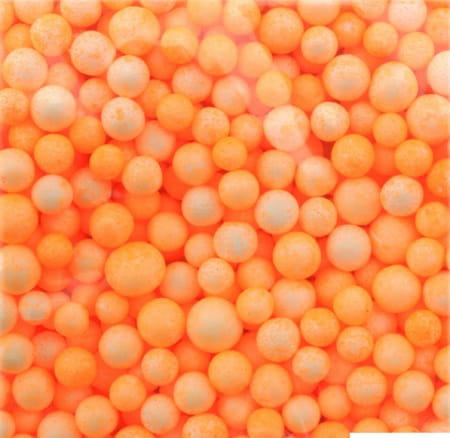
To keep the bait off the bottom, anglers will use eggs floaters in their spawn sacks (as seen in the picture), or floating beads or lil’ corky’s on the line to float the bait up and off the bottom.
Uusing a Drop Shot style plunking rig is a great way to elevate your bait and keep it at the desired level.
Plunking With Lures
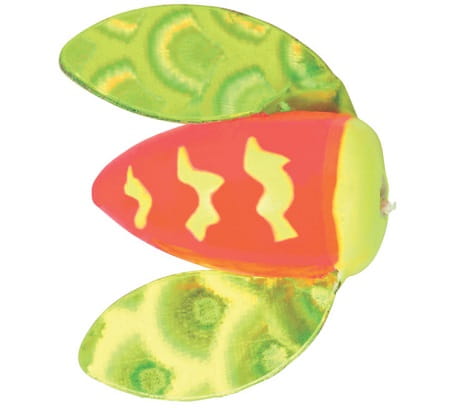
It is also possible to use lures like Spin N Glo, crankbaits, spoons, or one of my favorites, the Kwickfish Xtreme or Flatfish.
These lures sit in place and spin or wobble back and forth, and as the salmon swim close, they see it and grab it.
In some cases, like with the Spin N Glo, anglers tip the hook with a skein chunk, shrimp, or a minnow.
Spin-N-Glo lures have caught a lot of salmon and steelhead, and many anglers swear by them. I have also caught many steelies and salmon using Spin-N-Glo, but there are some things to make them more effective.
You should use three beads below the Spin-N-Glo to help prevent the hooks from fouling when casting and when in the drift. The beads also increase the distance between the hook point and the body of the bait, which gives you a better hooking percentage.
Be sure to use the correct hook size. Bigger is better. Your hook should be the same size or slightly bigger than the Spin-N-Glo, which will improve your hookups.
Many anglers will also tip the hook with a shrimp, live worm, lasting worm, twister tail, yarn, or skein, which does seem to increase the number of hookups for many anglers.
See the diagram below for the Spin-N-Glo rig for salmon fishing in rivers with the plunking method.
Flutter Spoons: A lightweight trolling spoon can also work. See Best Lures For Salmon.
Plunking Setups For Salmon: 2 Best Setups
The first setup is for plunking using lures. This is the most common plunking rig, and it’s adjustable. You can set your depth based on the length of your dropper.
You can also set your weight based on the velocity of the current. In a slower current, use fewer weights, and in a faster current, use more weights.
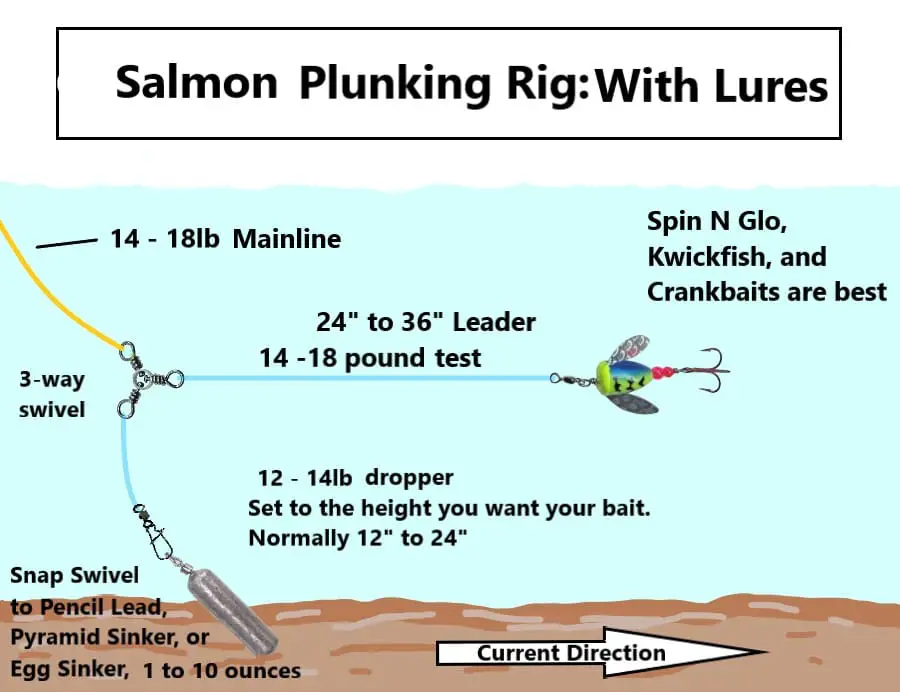
There are a number of ways to set up your rig, but for the sake of this post, these two are the most common plunking setups.
- To start with, you need a sturdy rod holder that you can knock/forge into the ground and will firmly withstand a steelhead strike when they bite.
- Tie a three-way swivel to the end of your mainline (I personally recommend a 50-pound braided mainline).
- Tie your leader to one of the eyes on the swivel. I personally recommend leader material made of monofilament and in the range of 12- and 15-pound test.
- Tie a long dropper line to the remaining eye on the swivel (about 8 to 20 inches)
- Tie a hook (octopus-style) to the end of your leader, ranging from 1/0 to 3/0, using an egg loop knot
- After tying the hook, slide down your spin and GLO choice and a bead matching the color of the lure.
- Attach a Duolock swivel to the end of the dropper and snap in a sinker weight via this duo lock (1 to 10 oz). For the best holding sinkers in strong currents, you should go for Pyramid or teardrop sinkers
- Some anglers always like to attach a bell on the rod, so that when a steelhead bites, it alerts them.
Salmon Plunking Rig For Baits
The plunking rig below shows you how to rig your line for baits like eggs. You can also use prawns, shrimp, worms, minnows, or even cut bait.
For salmon fishing around the Great Lakes, one of the hottest baits for this method, and one used by a lot of river guides, is Skein. Skein is the immature eggs still attached together by the egg membrane or skein.
Always ensure to check your rig frequently, especially when you’re fishing in high water means there will still be lots of junk that can get caught on your hook or bait.
How To Detect The Bite
Some anglers always like to attach a bell on the rod so that when a salmon bites, it alerts them. There’s really no rhyme to salmon bites when plunking, as it varies from one salmon to another.
Sometimes you get a series of taps that you will see on the tip of your rod that looks like a salmon bite. That could be a result of a salmon coming along and just grabbing your bait or lure and figuring out what is going on. Or it could just be a hit-and-run bite. In that case, your rod can get yanked if not properly kept.
Always look out for the tip of your rod when it loads up or shakes, and set the hook to check for a bite.
Tight Lines,
Graham

